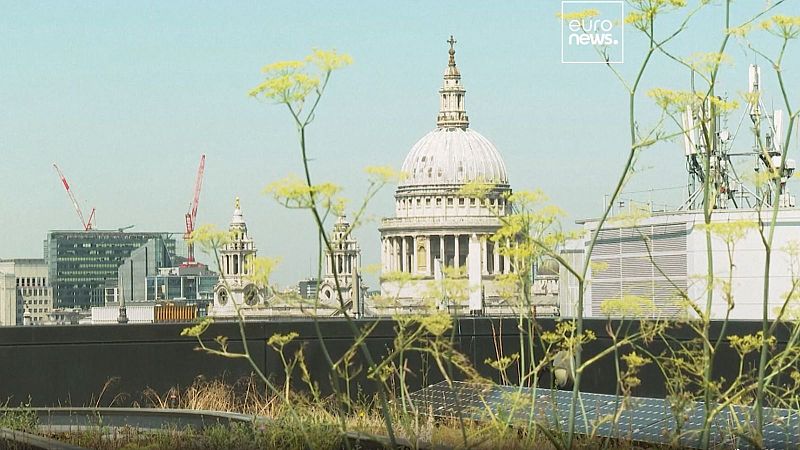Rare orchids and bees are thriving on London’s green rooftops as city eyes up cooling solutions

A bird’s eye view of London is increasingly appealing, with more and more rooftops turning green or white across the capital.
Green roofs involve planting vegetation up top, while the latter is essentially a paint job.
Both designs are intended to lower urban temperatures and keep people cool, but how do they work exactly - and which is more effective?
How do green roofs keep cities cool?
11 stories high, the green roof on top of investment bank Nomura's European headquarters in Moorgate, central London, is exemplary.
It is classed as a biodiverse, bio-solar green roof, consisting of a mosaic of habitats including sedums, open ground and longer meadow type vegetation, wildflowers, grasses and herbs.
The purpose of green roofs like this one is to help lower the air temperature.
Under the ‘urban heat island’ effect, temperatures can often be 10 degrees hotter in cities than rural areas as tall buildings trap heat and materials like asphalt and concrete absorb it.
As public health expert Mathilde Pascal told Euronews Green in a recent interview, 10 degrees is “the difference between something you can adapt to and something that is completely overwhelming.”
Plants help alleviate this effect as they store heat, which is then released when they transpire.
Why white roofs might be more effective
Researchers at University College London (UCL) analysed the temperatures of various different roofs and environments across the city of London on two hot summer days in 2018.
Their study found that while green roofs are effective in lowering temperatures during the day, they actually increase surrounding temperatures during the night.
“By transpiring - that's by sweating as we do - [plants] emit more heat into that form of latent heat, the heat that you can't perceive, so it's water vapour basically,” explains Oscar Brousse, Senior Research Fellow in Urban Climatology and Health at UCL.
Green roofs do decrease air temperature, he adds, but because they then heat up an area at night, you get a “null average decrease” in temperature.
The findings suggest that cool roofs might be a more effective roof modification system.
How do cool roofs work?
'Cool roofs' include roofs which are sprayed on with reflective properties, like white paint.
“The principle is that the energy that is coming from the sun is reflected back straight to the atmosphere and into space,” Brousse explains. “So, this energy that is coming in the first place is simply not accumulated in the city, in the buildings, in the streets, etc."
White roofs have the added advantage of being a lot lighter than green gardens, which in some cases can be prohibitively heavy for a building.
“The problem with the whitening of roofs,” however, “is the fact that it gets dirty and so its reflective capacity is lowered, and you have to make sure to maintain it always as white as possible.” This can be a costly bit of maintenance.
Green roofs bring biodiversity benefits too
In defence of green roofs, they not only help to lower daytime temperatures but bring manifold biodiversity benefits.
David Crowley, Environmental Manager at Nomura, thinks more green roofs should be developed on rooftops across cities for this reason.
"I think the more green roofs that we can get, especially in these highly urban areas the better,” he says.
“‘There's a lot of wildlife out there that still needs to thrive. Be it birds, be it moths, butterflies, bees… There's many species of creatures that need this kind of habitat. The more we can do to enhance that, it's going to enrich our lives as well," Crowley says.
This green roof has even attracted very rare orchids, which only grow at certain points in the year.
“I believe one of them is very rare and is the only one currently known in the UK,” adds Crowley.
The roof is not accessible to the public or the building's staff, so doesn’t get a lot of footfall. This suggests the potential for fragile species to thrive in these sky gardens.
Watch the video above to see London’s green and white roofs in action.

